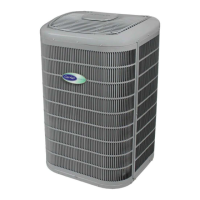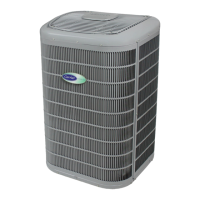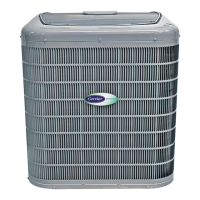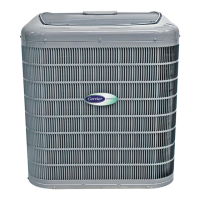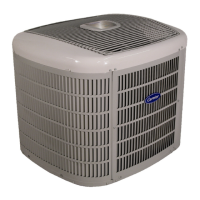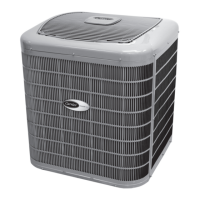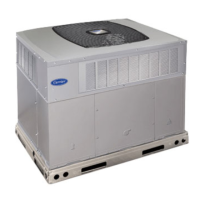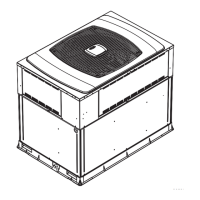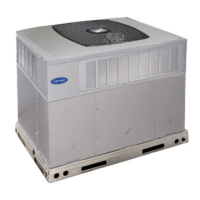24VNA6: Installation Instructions
Manufacturer reserves the right to change, at any time, specifications and designs without notice and without obligations.
12
Step 13 – System Functions and Major Components
The 24VNA6 models utilize an Infinity Communicating User Interface
(UI). When a demand for cooling exists, the wall control will direct the
outdoor unit to operate at the minimum required speed to satisfy
demand. With a call for cooling, the outdoor fan is energized followed
by the compressor to run at a start speed. Once the start criteria is met the
compressor and fan will ramp to the target demand. If continued
operation at the initial speed does not satisfy demand, the system will
ramp up in 60 RPM increments until it satisfies the demand. After
coping with the higher demand, the unit returns to lower capacity
operation until the demand is satisfied or until an increase in demand
occurs. Ideal performance is achieved when system operates
continuously at the lowest speed possible, minimizing variation in
conditioned space temperatures while using minimal power.
As the unit operates at lower capacity, system vapor (suction) pressure
will be higher than it is during a standard single-stage system operation
or during a higher capacity operation.
When all demand is satisfied, the compressor will shut off. An internal
pressure equalization valve will energize during the off-cycle to allow
for easy start up at the next call for cooling.
The conventional thermostat inputs is designed to work for emergency
operation only. Connections are Y1, Y2 and C. When Y1 is energized
the outdoor unit will operate at speeds equivalent to 1.5, or median,
demand. When Y1 and Y2 are energized, the system will operate at
maximum capacity.
The user interface (UI) displays the operation mode and fault codes as
specified in the troubleshooting section. See Table 7 for codes and
definitions.
NOTE: Only one code will be displayed on the outdoor unit control
board (the most recent, with the highest priority). The latest codes are
stored and can be accessed via the UI.
Primary Control Module
The Primary Control Module (PCM) controls the various functions of
the outdoor unit. The PCM has the following outputs:
1. Vapor Injection EXV
2. VFD Modbus communication
3. VFD low-voltage relay control
4. Pressure Equalization valve
5. O signal
6. W signal
7. Liquid Line Solenoid
The PCM has the following inputs:
1. Outdoor discharge thermistor (ODT)
2. Outdoor ambient thermistor (OAT)
3. Outdoor coil thermistor (OCT)
4. Discharge & suction pressure transducers (OPT)
5. Service Interface communication port
6. CCN communication (ABCD plug)
7. Model plug
8. 24VAC input power
The PCM receives a cooling demand from the wall control and
determines the appropriate compressor, fan, PEV, and LLS action based
upon the various sensor inputs.
Utility Interface With Infinity Control
The utility curtailment relay should be wired between the two UTIL
connections on the control board for this Infinity Communicating
System (see Fig. 26). This input allows a power utility device to
interrupt compressor operation during peak load periods. When the
utility sends a signal to shut the system down, the User Interface will
display: "Curtailment Active". See UI installation instructions for setup
details.
Infinity Control, Green Communications (COMM) Light
A green LED (COMM light) on the outdoor board (see Fig. 27) indicates
successful communication with the other system products. The green
LED will remain OFF until communication is established. Once a valid
command is received, the green LED will turn ON continuously. If no
communication is received within 2 minutes, the LED will be turned
OFF until the next valid communication.

